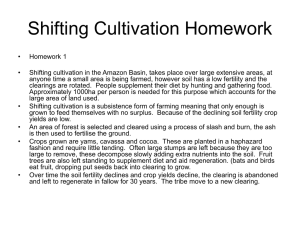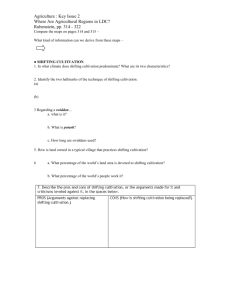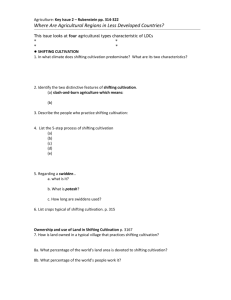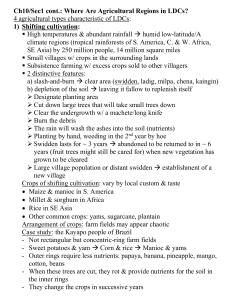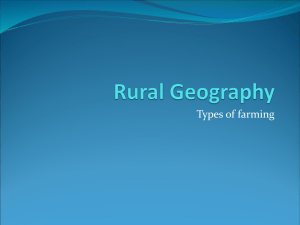2. Shifting Cultivation
advertisement
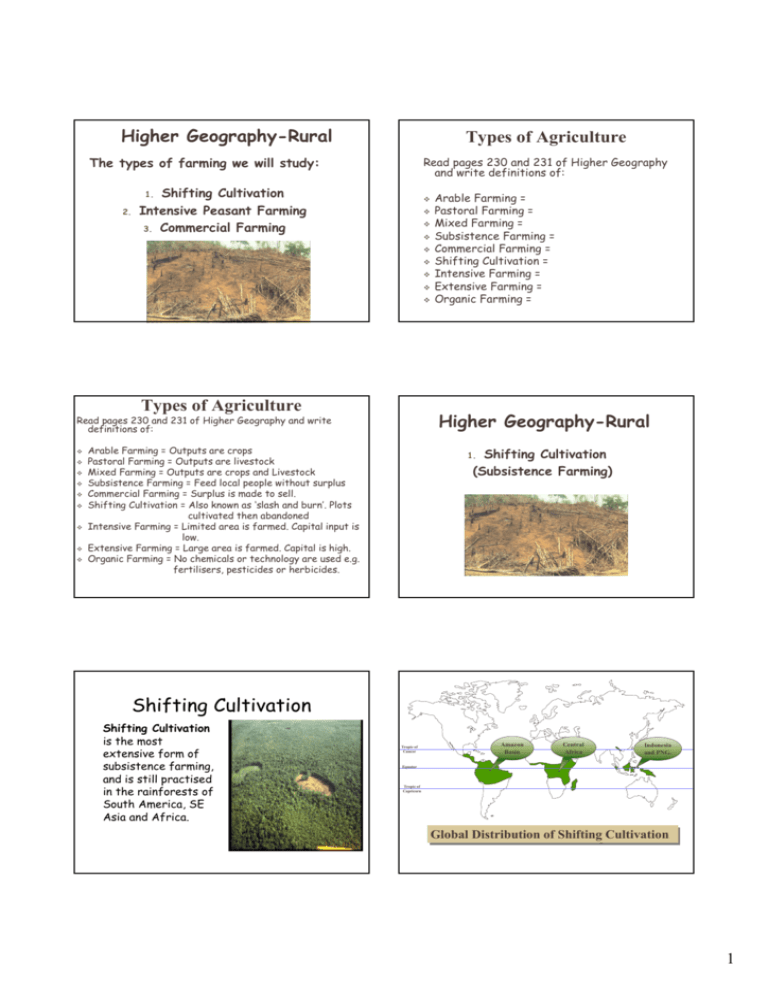
Higher Geography-Rural Types of Agriculture The types of farming we will study: Read pages 230 and 231 of Higher Geography and write definitions of: Shifting Cultivation Intensive Peasant Farming 3. Commercial Farming 1. 2. Types of Agriculture Higher Geography-Rural Read pages 230 and 231 of Higher Geography and write definitions of: Arable Farming = Pastoral Farming = Mixed Farming = Subsistence Farming = Commercial Farming = Shifting Cultivation = Intensive Farming = Extensive Farming = Organic Farming = Arable Farming = Outputs are crops Pastoral Farming = Outputs are livestock Mixed Farming = Outputs are crops and Livestock Subsistence Farming = Feed local people without surplus Commercial Farming = Surplus is made to sell. Shifting Cultivation = Also known as ‘slash and burn’. Plots cultivated then abandoned Intensive Farming = Limited area is farmed. Capital input is low. Extensive Farming = Large area is farmed. Capital is high. Organic Farming = No chemicals or technology are used e.g. fertilisers, pesticides or herbicides. Shifting Cultivation (Subsistence Farming) 1. Shifting Cultivation Shifting Cultivation is the most extensive form of subsistence farming, and is still practised in the rainforests of South America, SE Asia and Africa. Tropic of Cancer Amazon Basin Central Africa Indonesia and PNG. Equator Tropic of Capricorn Global Global Distribution Distribution of of Shifting Shifting Cultivation Cultivation 1 What is Shifting Cultivation? A small area of land is cleared and the vegetation burned, providing a source of nutrients from the ash. For a few years the soil remains sufficiently fertile for the tribe to grow crops. When the soil's fertility is exhausted, the tribe moves on and clears another small area of forest. The original area is regenerated, as it receives nutrients and seeds from surrounding vegetation. As no lasting damage occurs, this method of agriculture is sustainable. It is sometimes called 'slash and burn' agriculture. The main crops are maize, manoic, yucca, yams and cassava. Yields are low and protein is added to the diet through hunting, gathering and fishing. Practiced in the Tropical Rainforests of the world, such as Amazonia, central Africa and south east Asia, where population density is low. It is a small-scale, primitive but sustainable (environmentally friendly) form of agriculture in which a small plot of land is used but a large area is required. A typical family unit of 20 people uses around 120 hectares. Shifting Cultivation Shifting Cultivation So this system is perfect….. Or indeed was perfect…….. An estimated population exceeding 250 million people derive subsistence from the practice of shifting cultivation, and ecological consequences are often negative, but are not as severe provided new forests are not invaded.- Concept of ‘Slash and Burn.’ Two changes A) Change to the environment- The forests in which shifting cultivation is practised are now seen by the countries which control them as a source of wealth to be used to benefit the whole country, not just the people who live there. 2 Example:Brazil The government in Brazil now see the Rainforest as a stimulant for the rest of the country’s economy. So….. The result…. The result is the destruction of the rainforest, and the pushing back of the shifting cultivators, so they have less and less land. This means that the soil is not allowed sufficient chance to regenerate, and the fertility declines. The Effects Increased population has meant: Land is fallow/fertile for a shorter period of time. Crops are being grown on a larger area of land New villages are being created Crops and timber are being sold to buy more food Amazonia is rich in minerals needed in the factories in the South. Timber is needed both at home and to sell abroad. Poor people from the North East need farmland People need beef, and cattle ranches can be carved out of the forest. These empty lands are to be secured against colonisation from Brazil’s neighbours, e.g. Peru Two changes B) Change to the people- Within communities themselves, changes are having an impact on the agricultural system. Improvements in communications have led to an increase in health-care, and this has had an unforeseen effect. Summary of Shifting Cultivation 1) Natural Forest is cleared. Trees which provide food crops, as well as large trees used to shelter ground crops are allowed to remain. The felled trees dry out and are burned. This kills off weeds, and provides a layer of fertile ash. This is where the term ‘slash and burn’ originates. 3 Summary of Shifting Cultivation 2) The village is built and crops are grown for use of the people that live within it. Remember, shifting cultivation is subsistence farming! Summary of Shifting Cultivation 4) After a few years the clearing is abandoned, and the people have to move elsewhere. Therefore, stages 1-3 will repeat in a different area of the rainforest. Summary of Shifting Cultivation Summary of Shifting Cultivation 6) After a few years, the clearing has integrated into the forest. Overall, this cycle has repeated itself over time, and has only ran into complications with recent developments. 5) The clearing is recognised by plants, both by the trees which survive and from the surrounding forest. Thus, the area will over a period of approx. 25 years ‘regenerate itself’. Main Characteristics of Shifting Cultivation Summary of Shifting Cultivation 3) The soil begins to lose it’s fertility as now the nutrient cycle has been broken by human interference. Clearings are made in the rainforest by cutting down and burning trees. Cultivation refers to the practice of growing crops in the clearing, using ash as fertiliser. Shifting refers to the practice of moving to another clearing as the soil becomes exhausted. This is due to the shortened fallow period. It is a ‘subsistence’ method of farming (only enough crops are grown to support the population) This farming system is labour intensive and only supports low population densities. Hunting and gathering also practiced to provide protein to the diet. 4


